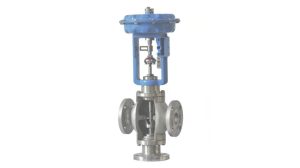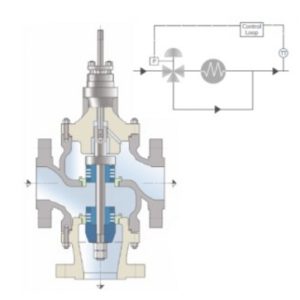Troubleshooting Tips for 3 Way Globe Valve: Common Issues Solved
Exploring 3 Way Globe Valve Functionality
Overview of 3 Way Globe Valve Design
The 3 way globe valve is a multi-purpose body and is suitable for various industrial applications to carry out many functions but widely it is used to control the flow of fluid with rotating actuation. With the ability to regulate, mix, or divert flow, its distinctive design is fundamental to any system with precise control. As a result, it is unique as it can be used to control, mix, or divert flow, in systems that require detailed control.
Components of a 3 Way Globe Valve
|
Component |
Description |
|
Body |
The main structure housing the internal components. |
|
Bonnet |
Covers the valve body and houses the stem and packing. |
|
Stem |
Connects the actuator or handwheel to the valve disc. |
|
Disc |
Moves to open or close the valve, controlling flow. |
|
Seat |
Provides a sealing surface for the disc to prevent leakage when closed. |
|
Packing |
Seals around the stem to prevent fluid leakage. |
|
Actuator |
Mechanism that moves the stem and disc, can be manual, electric, or pneumatic. |
Flow Paths and Control Mechanisms
3 way globe valve has 3 ports where fluid enters or exits and it will determine the types of flow path allowed through it. One incoming stream can be combined into a single outgoing stream or split into two separate paths. Control Strategies typically have actuators to set the disc Position for controlling the flow.
Identifying Common Issues with 3 Way Globe Valves
Symptoms of Malfunctioning Valves
Recognizing early signs of malfunction in a 3 way globe valve is crucial for maintaining system efficiency and preventing downtime.
Unusual Noise and Vibration
Identification a symptom which is common is There is strange sound or vibratory whilst working. That could be a sign of problems, like cavitation, which means vapor bubbles are created by and collapse inside the valve, generating this noise and possibly damaging it.
Inconsistent Flow Rates
Another sign of trouble is inconsistent flow rates, which may result from obstructions within the valve or improper seating of the disc.
Diagnosing Valve Performance Problems
Accurate diagnosis is key to resolving performance issues effectively.
Visual Inspection Techniques
Start with a complete visual check. Inspect external components such as the stem and bonnet for signs of wear, and inspect for visible leaks around seals and packing. Inspect external parts such as the stem and bonnet for signs of wear or friction and leaks should be visible around seals and packing.
Pressure Testing Procedures
Conduct pressure tests to assess sealing integrity. This involves applying pressure to one side of the valve while monitoring for leaks on the other side.
Effective Troubleshooting Techniques for Optimal Performance
Addressing Leakage Concerns
Leakage is a prevalent issue that can compromise system efficiency.
Causes of Leakage in 3 Way Globe Valves
Leakage often stems from worn seals or improper seating of the disc against the seat. Over time, packing may degrade, leading to leaks around the stem area.
Repair and Maintenance Strategies
To address leakage, replace worn seals and packing materials promptly. Regular maintenance should include checking seal integrity and ensuring proper alignment of components during reassembly.
Resolving Actuator Malfunctions
Actuators play a critical role in valve operation; their failure can lead to performance issues.
Identifying Actuator Failures
Signs of actuator failure include unresponsiveness or erratic movement during operation. Electrical actuators may exhibit wiring issues, while pneumatic ones might suffer from air supply problems.
Calibration and Adjustment Methods
Ensure actuators are correctly calibrated according to manufacturer specifications. Adjustments may involve realigning mechanical linkages or recalibrating electronic controls to ensure accurate positioning of the valve disc.
Tackling Blockage and Obstruction Issues
Blockages can severely impact flow efficiency within a system using a 3 way globe valve.
Common Sources of Blockages
Blockages typically arise from debris accumulation within the valve body or foreign particles obstructing the seating area.
Cleaning and Clearing Procedures
Carefully disassemble the valve and its internals — following safety protocols if necessary — or provisions to open them up to clear blockages. Use appropriate solvents or tools for cleaning internal surfaces – relevant to your specific application needs. Put everything back together, but mind the proper fitment and torque specs, so it won’t get in the way anymore.
Enhancing Longevity and Reliability of 3 Way Globe Valves
Routine Maintenance Practices
Ensuring the longevity and reliability of 3 way globe valves requires consistent maintenance practices. These measures not only extend the valve’s lifespan but also enhance its performance under various operational conditions.
Scheduled Inspection Protocols
A routine inspection protocol to identify possible problems would be beneficial. Periodic checks should look for signs of wear, corrosion, or other damage to critical components like the stem, disc, and seat. A clean inspection routine lets the operators fix tiny issues before they blossom into large and costly failures.
Lubrication and Component Replacement
Lubrication helps to reduce wear by minimizing contact between the moving parts. Lubricants are compatible with valve materials and the media which will be transferred through the valve must be utilized. Moreover, by routinely replacing the seals, packing, and other worn components, you ensure the best possible sealing and minimize the chance for a leak. Regularly replace worn components such as seals and packing to provide effective seals and leakage-free sealing.
Upgrading Systems for Improved Efficiency
Modernizing existing systems can significantly improve the efficiency and functionality of 3 way globe valves.
Integration with Modern Control Systems
3 way globe valves can be cascaded with advanced control systems for minimizing flow rates and better system stability. Electric or pneumatic actuators can be used for automation for better control of valves to achieve process efficiency. Electric or pneumatic actuators provide automation capability to enable more precise control of the valve operation in turn enhancing process performance.
Retrofitting Options for Existing Installations
Upgrading components or technologies in existing facilities is possible to improve performance without needing to replace the whole system. These options include the upgrade of the actuators to high-performance ones or the upgrades for the advanced sealing technologies with wear and chemical resistance. These include installing higher-end actuators or advanced sealing technologies that would create a stronger threshold in order to prevent wear, damage, and chemical exposure.
Expanding Horizons with Miwival Solutions
At Miwival, you can discover a wide range of innovative applications specifically designed for your diverse industrial solutions. The products they create are designed to last, work well, and have a low downtime rate which makes them ideal for 3 way globe valve systems. With a mission to make the world better through their products, which are designed for durability, efficiency, and reliability, they are a premium option to upgrade 3 way globe valve applications.
Advantages of Choosing Miwival Products
It is their design and construction that give Miwival products an edge over their competitors. Using high-tech materials — such as stainless steel — to resist corrosion and wear. Another advantage is that the integrated stem seals of Miwival valves self-adjust with the operated conditions of temperature and pressure which guarantees a high reliability life cycle. Miwival valves also employ self-adjusting stem seals that hold against different temperature and pressure conditions without fail over time; thus, delivering dependable performance over time.







